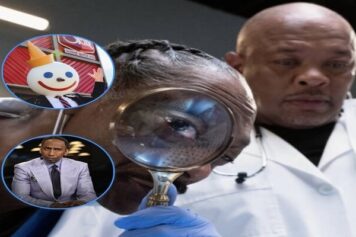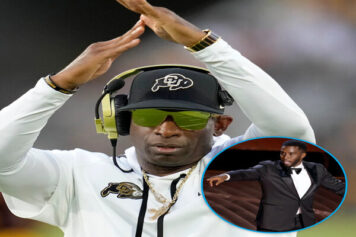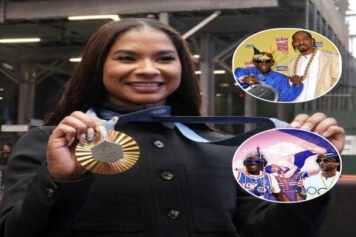On this 20th anniversary of the December 15th release of the Chronic, I’ll admit it: Before I even heard the entire game-changing, California-soaked, weed-induced 1992 Dr. Dre masterpiece, I was on full-blown hate. Sure, like everyone else in the hip-hop nation, I was geeked by the enormous promise of Dre’s first single 1992 “Nuthin' but a 'G' Thang,” a seriously laid-back joint that was the perfect platform for fresh-face Long Beach rapper and future rap icon by the name of Snoop Doggy Dogg. It was the type of track that screamed to mainstream rap buyers: “HEY, YOU…REMEMBER HAMMER’S TOO LEGIT TO QUIT JOINT THAT YOU THOUGHT WAS LEGIT? WELL, THAT AIN’T LEGIT…AT ALL.”
And there was more to dig: like Dre’s ever-evolving production style, fueled by a slinky bassline and Moog keyboard that was at full embracement of all that was funky; the landmark video for “G Thang” proudly displayed Los Angeles’ ‘hood lifestyle from its old school low rider car culture, beach barbecues and bikini-clad chicks, to an effortlessly flowing Snoop, who was so shy that he barely looked into the camera. West Coast hip-hop culture was on full display.
But the song that made me initially wash my hands of Andre Young was the infectious “Let Me Ride” is what brought on the hate. Let’s be clear: as a Parliament Funkadelic STAN this track would later become my favorite song that ever sampled the genius George Clinton contingent. But I had to get over a heavy obstacle, more specifically the following line: “No medallions, dreadlocks, or black fists/It's just that gangster glare, with gangster raps, that gangster shit, makes a gang of snaps.” At that moment, Dr. Dre had declared war on all my hip-hop philosophical sensibilities.
You see, I was a “socially conscious” hip-hop head (that wasn’t a slur, back then). Don’t get it twisted, though, as a born and bred Chicago native, my cities’ Midwestern proximity meant that, during the late 80s/early 90’s we listened to it all across the rap spectrum. We worshipped at the altar of Run-DMC, yet we were hardcore Geto Boys and NWA fanatics. We understood the lyrical greatness of Rakim, but we also were well aware that nothing sounded better coming out of the speakers of your whip than the foul mouth, bass-driven hilarity of Too $hort. I had love for everyone from MC Lyte to West Coast gangsta rap pioneer Ice T, but my favorite acts seemed to always include the type of MCs you could imagine delivering a speech at Harvard on the history of COINTELPRO.
It was the ferocious Public Enemy declaring their allegiance to the Honorable Louis Farrakhan on “ Don’t Believe The Hype.” It was Boogie Down Productions’ intelligent, yet incendiary front man KRS-One appearing on the cover of their seminal 1988 album, By All Means Necessary, peaking out of the window, gun in hand, Malcolm X-style. It was the left field, all-natural statements of the Native Tongues crew, which included standouts the Jungle Brothers, De La Soul and A Tribe Called Quest. And there was the boldness of Queen Latifah, an MC who rhymed of female empowerment and black pride with a dynamic flow and cockiness that could stand toe-to-toe with the boys.
This was the era (from 1988 to 1991) when damn near everyone in hip-hop was required to drop some kind of knowledge on wax. The aforementioned Rakim and Big Daddy Kane introduced the Five Percent Nation to the masses. X-Clan preachedhardcore afro centrism and black nationalism. The usually insulated rhyme-monster LL Cool J, who rapped about sipping champagne and creeping with your girl when he wasn’t battling Kool Moe Dee and Ice T, was writing songs about the Mother Land and the power of God on Walking With a Panther. Socially conscious lyricism and pro-black ideology was so prevalent in hip-hop that even the Godfather of gangsta rap Schoolly D — the same dude who first repped his Philadelphia Park Side Killers crew on the 1985 classic “PSK” — was getting in on the act with 1989’s Am I Black Enough for You?.
“I grew up in a multi-racial family,” explains Schoolly when I asked him about his shocking, red, black and green inspiration on tracks like “Black Jesus,” “Don't Call Me Nigger,” and “Education of a Black Man.” “And on my father’s side was all black nationalists. And my father always told me, ‘Don’t ever let the white man tell you how to be black.’ You can go up and bust it up on Friday and go to church on Sunday and mentor kids on Monday. Why do you have to be one-dimensional to be a black man? I’m not a one-dimensional black man. I’m 4D”
Continues Schoolly D: “That album turned out to be one of my best put together records. It was a great concept record in my mind. Jive thought I was crazy to make that album. They told me, ‘We are not putting this out.’ And I said, ‘Yes you are.’”
So flash ahead to 1992. I’m in the car with my boy Carlos (RIP, dog) driving on 87th and King Drive on the Southside of Chicago. And the convo went like this:
Los: “You heard that Chronic yet?”
Young Murph: “Nah, I heard Dre and them are on that kill-a-nigga sh*t. They not even trying to kick some street knowledge like Ice T and Cube.”
Los: “Dog, you gotta listen to this whole album. I ain’t never heard anything like it.”
Young Murph: “That ‘G Thang’ joint was dope. But did you hear Dre say no black medallions, no black fist? Dude is on some sellout sh*t.”
Los: “I’m going to play it for you…just give it a chance.”
What happened next was a revelation. From the Chronic’s menacing intro, it was evident that hip-hop would never be the same. “Niggas with attitudes? Naw, loc…Niggas on a motherf***ing mission,” claimed Snoop. This was the new era of Death Row Records. You could almost envision an imposing Suge Knight somewhere in the recording studio, wearing all red everything, giving off a knowing sneer with the understanding of what was to come. “ Fu*k wit Dre Day (And Everybody's Celebratin’)” wasn’t so much a warning shot, it was an opening attack on former NWA partner Eazy E, the 2 Live Crew’s Uncle Luke, and anybody else foolish enough to get in the way of Dr. Dre and his hood-mashing clique. It was menacing, overtly violent, nihilistic gangsta sh*t. It was also straight up exceptional.
Up until that moment, I had never heard an album as sonically clean as the Chronic. This was pure ear candy; an album that was mixed and mastered as if Steely Dan had booking time. The Chronic had hilarious, profane skits that rivaled De La’s 3 Feet High and Rising (hearing the DOC on the faux game show “20 Sack Pyramid” still cracks me up). It was as masterfully sequenced as Tribe’s The Low End Theory. And the Chronic contained perhaps the most impressive collection of MCs on one album pre-Wu Tang Clan.
Franchise player Snoop had a disarming lyrical approach that was as melodic as it was frightening. RBX sounded like the voice of God.Tha Dogg Pound’s Daz flexed as a criminally underrated producer (rumor has it he ghost-produced some of the actual beats on the Chronic), while his partner Kurupt could seemingly battle anyone on the planet holding a mic. The intimidating Lady of Rage made you re-think everything you believed a female MC was capable of doing. And leading the entire charge was Dr. Dre, who was solidifying his status as hip-hop’s leading studio visionary.
“Dre’s musical ability was to take enough music over time and slow music down from the crack era to the weed era,” says respected rhyme giant Chuck D, who was recently inducted into the Rock and Roll Hall of Fame as a member of Public Enemy. “He slowed the tempo down and that was one of the greatest achievements of the Chronic.”
Indeed, there are many standout moments on the Chronic. “Lil Ghetto Boy” offered a soulful and unflinching look at life growing up in the senseless madness of the ‘hood. “A Nigga Witta Gun” turned shoot ‘em up threats up to 1000. “Lyrical Gangbang” easily ranks amongst the most revered posse cuts ever recorded in hip-hop. And “Bitches Ain’t Shit” was unapologetically misogynistic, and yet it still soared. I felt guilty for loving the damn song.
But it was the powerful “The Day the Niggaz Took Over” that truly blew my mind.
There was nothing filtered about this track. It was literally the pure rage of black and brown folks rioting in Los Angeles after white policemen got off with a not-guilty verdict following the savage 1991 beating of the late Rodney King.
“Laugh now but cry much later,” a sober Dre said of the senseless outcome over a nightmarish, adrenaline-injected track, later dictating, “Let's jump in off in Compton so I gots ta get my loot on and come up on me some furniture or something/Got a VCR in the back of my car that I ganked from the Slauson Swap Meet/ And motherf***ers better not try to stop me…” This was as powerful as anything P.E. set to the Bomb Squad’s 1000 beats-per-minute sound clash. By the end of the album, I had to admit to the homie Los that I was sold. The Chronic was indeed the proverbial bomb.
“My thoughts when the Chronic came out? Jealously,” muses Schoolly D. “All of the music on that album was the stuff that I grew up on. Before hip-hop, and I’ll tell anybody, I’m a funkateer by heart. Funk is my heart and rap is the blood that flows within that. It was just an incredible album.”
The Chronic would go on to become the biggest selling hardcore hip-hop album of all-time up until that point, pushing more than four million copies. Dre and crew crossed over on their own terms, never bothering to record a typical “radio single.” Gangsta rap was now as mainstream as Michael Jackson and apple pie. But the success of the Chronic signaled the end for the socially conscious hip-hop movement. BDP, PE, De La, and Tribe would survive off their ability to not be pigeonholed by one style or genre. Yet others like X Clan, Poor Righteous Teachers, and Paris found it increasingly hard to make commercial progress in this Chronic World Order.
It was as if everyone in hip-hop wanted to be a gangsta. LL was suddenly adopting some of the G’d up West Coast sounds on 14 Shots to the Dome (1992), delivering images of blatant gun-play. Following the departure of lead MC Grand Puba, 5 Percent troop Brand Nubian went straight goon on East Coast fueled tracks like “Pass The Gat” and “Punks Jump Up To Get Beat Down.” Def Jam signed a quite attractive, middle-class Detroit native turned Los Angeles female spitter by the name of Boss and transformed her into the ultimate gun-toting bitch (her words, not mine) with her 1993 debut album Born Gangstaz. Onyx wanted to shoot the place up. The message was clear: if you wasn’t about that gangsta sh*t you were seemingly out of place.
But Chuck D has another theory on Dre’s dismantling of the black medallion faction of hip-hop. “I don’t think [The Chronic] hurt the entire conscious hip-hop scene, but a lot of the conscious rappers couldn’t find a way to be conscious and just flow in that laidback manner,” he explains. “I think the drawback was the actual live performance aspect. People didn’t really know how to perform the slower rap music better. I think up-tempo rap music had better live performances, up until that point, because you had dancers and people were hype and people were hype to come into the building. Dre was a part of that because he made hype NWA music, but once he slowed it down with the Chronic, performances in hip-hop went to a different speed and became more laidback.”
The Chronic should be remembered for a myriad accomplishments. It was bold, culture-shifting, scary, and prophetic. Without it, there would be no Doggystyle (Snoop Dogg), Ready To Die (Notorious BIG), and other great statements that moved and shaped us. Even with its legion of lazy copycats, its brilliance shines on. But, as I turn on the radio today and hear the sounds of Chicago’s buzz-heavy Chief Keef, I am reminded of what happens when young, raw (and far less talented) rappers walk the same line as Dr. Dre’s Chronic, twenty years later. It ain’t the same. In fact, it’s enough to make me dust off my old X-Clan tape. To the East, my brother…to the East.



